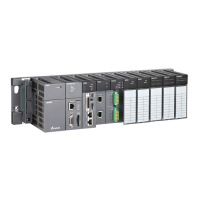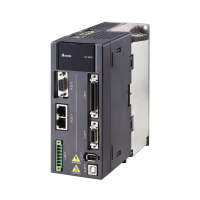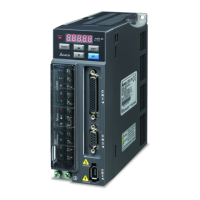AH500 Programming Manual
6-82
API
Instruction code Operand Function
0204 D INT P
S, D
Converting the 32-bit floating-point
number into the binary integer
Device
X Y M S T C HC D L SM SR E PR K 16# “$” DF
Pulse instruction
16-bit instruction (5 steps)
32-bit instruction (5 steps)
Symbol:
S
:
Source device Double word
D
:
Conversion result Word/Double word
Explanation:
1. The single-precision floating-point number in the register specified by S is converted into the
binary integer. The binary floating-point number is rounded down to the nearest whole digit,
and becomes the bianry integer. The binary integer is stored in the register specified by D.
2. The source device S used in the instruction INT occupies two registers, and D used in INT
occupies one register.
3. The source device S used in the instruction DINT occupies two registers, and D used in DINT
also occupies two registers.
4. The operand D used in the instruction INT can not be the 32-bit counter.
5. The instruction INT is the opposite of the instruction FLT.
6. When the conversion result is zero, SM600 is ON.
7. During the conversion, if the floating-point number is rounded down to the nearest whole digit,
SM601 will be ON.
8. When the conversion result exceeds the range, SM602 is ON.
9. For the instruction INT/IINTP, the range of conversion results is between -32,768 and 32,767.
10. For the instruction DINT/DINTP, the range of conversion results is between -2,147,483,648
and 2,147,483,647.
Example:
1. When X0.0 is ON, the single-precision floating-point number in (D1, D0) is converted into the
binary integer, and the conversion result is stored in D10. The binay floating-point number is
rounded down to the nearest whole digit.
2. When X0.1 is ON, the single-precision floating-point number in (D21, D20) is converted into
the binary integer, and the conversion result is stored in (D31, D30). The binary floating-point
number is rounded down to the nearest whole digit.

